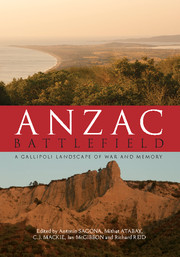Book contents
- Frontmatter
- Foreword
- Contents
- Figures
- Plates
- Contributors
- Acknowledgements
- Abbreviations
- Gallipoli battlefield place names
- Introduction
- 1 Boundary and divide: The antiquity of the Dardanelles
- 2 The Gallipoli campaign: History and legend
- 3 Recording the battlefield: First steps
- 4 Capturing the battlefield: Mapping and air photography at Gallipoli
- 5 Battlefield archaeology: Gallipoli
- 6 Forming the ANZAC battlefield
- 7 Forming the Ottoman battlefield
- 8 Artefacts from the battlefield
- 9 Remembering Gallipoli
- 10 Remembering Gallipoli from a Turkish perspective
- Conclusion
- Appendix Anzac Gallipoli Archaeological Database
- References
- Index
9 - Remembering Gallipoli
Published online by Cambridge University Press: 05 December 2015
- Frontmatter
- Foreword
- Contents
- Figures
- Plates
- Contributors
- Acknowledgements
- Abbreviations
- Gallipoli battlefield place names
- Introduction
- 1 Boundary and divide: The antiquity of the Dardanelles
- 2 The Gallipoli campaign: History and legend
- 3 Recording the battlefield: First steps
- 4 Capturing the battlefield: Mapping and air photography at Gallipoli
- 5 Battlefield archaeology: Gallipoli
- 6 Forming the ANZAC battlefield
- 7 Forming the Ottoman battlefield
- 8 Artefacts from the battlefield
- 9 Remembering Gallipoli
- 10 Remembering Gallipoli from a Turkish perspective
- Conclusion
- Appendix Anzac Gallipoli Archaeological Database
- References
- Index
Summary
Of all the battle sites of the Gallipoli campaign, the Anzac battlefield has changed least in the century that has elapsed since the withdrawal of the Allies. It is also the area that has become the most important in terms of remembrance of the campaign. There are two primary reasons for this. First, most of the terrain on which the fighting took place was unsuitable for farming; there were in consequence few former inhabitants to return to the area following the end of the battle, and little incentive for anyone else to attempt to make a living there. The battlefield amid the steep ridges and deep valleys was always destined to revert to its previous untilled state. Second, the two countries that had made the main Allied effort in the area, Australia and New Zealand, retained a deep sentimental connection to it – a connection that was perhaps reinforced by the very remoteness of the site from these most distant of the combatants. Their determination to provide a fitting memorial to the sacrifice of their men would result in a unique regime of commemoration – the reservation of an entire area as a cemetery in addition to the conventional enclosure-type resting places for the empire's soldiers.
Not only did the two South Pacific dominions invest much effort in the establishment of the area in the immediate aftermath of the war but also they have led the way in commemorating the campaign in more recent times. Three distinct phases have marked the evolution of the Anzac Area: definition, construction and engagement. The delineation of the area was the product of diplomacy at the highest levels. The imperial commemorative structures it contains were built under an arrangement that was unusual in the context of the post-war approach to war graves provision. Engagement has been dominated for decades by Australians, New Zealanders and Turks, making pilgrimages to the place where relatives took part in the fighting, often to their graves or memorials; more recently, they have been joined by many others seeking some sense of personal connection to a place that resonates deeply in their national narratives.
In recent years there has been increasing academic engagement with the commemorative story of the Anzac area, more especially since large crowds of young Australian and New Zealand backpackers have visited Anzac Cove, Lone Pine and other sites for Anzac Day.
- Type
- Chapter
- Information
- Anzac BattlefieldA Gallipoli Landscape of War and Memory, pp. 192 - 221Publisher: Cambridge University PressPrint publication year: 2016
- 3
- Cited by

